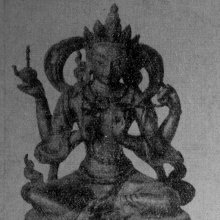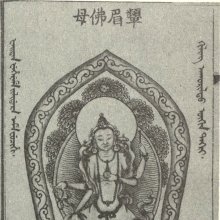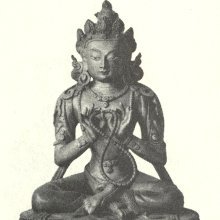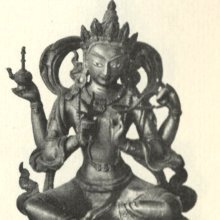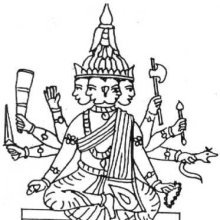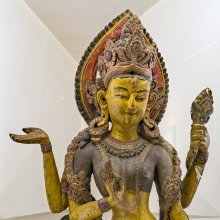Bhrikuti, Bhṛkuṭī: 21 definitions
Introduction:
Bhrikuti means something in Buddhism, Pali, Hinduism, Sanskrit, Jainism, Prakrit, Marathi, Hindi. If you want to know the exact meaning, history, etymology or English translation of this term then check out the descriptions on this page. Add your comment or reference to a book if you want to contribute to this summary article.
The Sanskrit term Bhṛkuṭī can be transliterated into English as Bhrkuti or Bhrikuti, using the IAST transliteration scheme (?).
Images (photo gallery)
(+6 more images available)
In Hinduism
Shaivism (Shaiva philosophy)
Source: Wisdom Library: Kubjikāmata-tantraBhṛkuṭī (भृकुटी, “frowning”):—One of the nine Dūtī presided over by one of the nine bhaivaravas named Caṇḍalokeśa (emanation of Ananta, who is the central presiding deity of Dūtīcakra), according to the Kubjikāmata-tantra and the Ṣaṭsāhasrasaṃhitā.

Shaiva (शैव, śaiva) or Shaivism (śaivism) represents a tradition of Hinduism worshiping Shiva as the supreme being. Closely related to Shaktism, Shaiva literature includes a range of scriptures, including Tantras, while the root of this tradition may be traced back to the ancient Vedas.
Kavya (poetry)
Source: Brill: Śaivism and the Tantric Traditions (kavya)Bhṛkuṭi (भृकुटि) refers to a “frown (of the brows)”, according to Bāṇa’s Kādambarī (p. 225-226).—Accordingly, while describing the shire of the Goddess Caṇḍikā, “[Then follows the image of the Goddess Caṇḍikā, which matches the conception of Kālarātri in the passage from the Mahābhārata:] [...] she bore the coquettish apparel of a woman going out to meet Mahākāla at night, with a vine-like body furnished with a raiment reddened with saffron-dye, with a face with red eyes, whose brows were furrowed into a frown (bhṛkuṭi-kuṭila-bhru), whose lip was crimsoned with betel that was blood, whose cheeks were reddened by the light shed from ear-ornaments of pomegranate flowers, with a forehead on which there was a tilaka dot of vermillion made by a Śabara beauty, covered by a magnificent gold turban. She was worshipped by goats... mice... antelope and black serpents... She was praised on all sides by flocks of old crows; [...]”.

Kavya (काव्य, kavya) refers to Sanskrit poetry, a popular ancient Indian tradition of literature. There have been many Sanskrit poets over the ages, hailing from ancient India and beyond. This topic includes mahakavya, or ‘epic poetry’ and natya, or ‘dramatic poetry’.
In Buddhism
Tibetan Buddhism (Vajrayana or tantric Buddhism)
Source: Wisdom Library: Tibetan BuddhismBhṛkuṭī (भृकुटी) is the name of Vidyārājñī (i.e., “wisdom queen”) mentioned as attending the teachings in the 6th century Mañjuśrīmūlakalpa: one of the largest Kriyā Tantras devoted to Mañjuśrī (the Bodhisattva of wisdom) representing an encyclopedia of knowledge primarily concerned with ritualistic elements in Buddhism. The teachings in this text originate from Mañjuśrī and were taught to and by Buddha Śākyamuni in the presence of a large audience (including Bhṛkuṭī).
Source: archive.org: The Indian Buddhist Iconography1) Bhṛkuṭī (भृकुटी) refers to a deity from the Yellow Tārā family, according to Buddhist Iconography.—Bhṛkuṭī is yellow and emanates from Amitābha. She is one-faced and four-armed, shows the Varadamudrā and the rosary in the
two right hands and carries the Tridaṇḍī and the Kamaṇḍalu in the two left. [...] Strictly speaking, only those deities can be called Tārās to whom the mantra: “oṃ tārā tuttāre ture svāhā” is assigned. [...] From the colour of the different Tārās it will be possible to refer them [viz., Bhṛkuṭī] to their respective Kulas or families presided over by the five Dhyāni Buddhas.
2) Bhṛkuṭī (भृकुटी) refers to one of the various (female) emanations of Amitābha having their Sādhana described in the 5th-century Sādhanamālā (a collection of sādhana texts that contain detailed instructions for rituals).—Her Colour is yellow; she has four arms.—Bhṛkuṭīi is another goddess emanating from the Dhyāni Buddha, Amitābha of red colour. She is already familiar as a companion of Avalokiteśvara as a minor goddess.
The Dhyāna (meditation instructions) of Bhṛkuṭī described in the Sādhanamālā as follows:
Source: academia.edu: The Structure and Meanings of the Heruka Maṇḍala“The goddess Bhṛkuṭī should be conceived as four-armed, one-faced and yellow in colour, three-eyed and as blooming with youth. She shows the varada-mudrā and the rosary in her two right hands,and carries the tridaṇḍī and the kamaṇḍalu in the two left. Her crown is stamped with the effigy of Amitābha. She sits on the orbof the moon over a lotus. Thus meditating...”
[Another Sādhana adds the information that Bhṛkuṭī should be peaceful in appearance and should wear a crown of matted hair.]
Bhṛkuṭī (भृकुटी) or Bhṛkuṭikī is the name of a Ḍākinī who, together with the Vīra (hero) named Bhṛkuṭa forms one of the 36 pairs situated in the Hṛdayacakra, according to the 10th century Ḍākārṇava chapter 15. Accordingly, the hṛdayacakra refers to one of the four divisions of the sahaja-puṭa (‘innate layer’), situated within the padma (lotus) in the middle of the Herukamaṇḍala. The 36 pairs of Ḍākinīs [viz., Bhṛkuṭī] and Vīras are reddish yellow in color; they each have one face and four arms; they hold a skull bowl, a skull staff, a small drum, and a knife.
Source: Rangjung Yeshe Wiki: Dharma DictionaryBhṛkuṭī (भृकुटी) or Bhṛkuṭītārā (in Tibetan: khro gnyer gyo ba'i sgrol ma) refers to the “Tārā with a frown” and represents one of the twenty-one emanations of Tārā according to the Kashmiri Mahasiddha Suryagupta Tradition.—Suryagupta or Ravigupta (Tibetan: nyi ma be pa) was a layperson from Kashmir that was cured of leprosy by a miraculous statue of the goddess Tara. Suryagupta is famous for having many visions of Tara and originating many lineages of her practice such as the Twenty-one forms of Tara [e.g., Bhṛkuṭī-tārā]. There exists inscriptions and paintings (from the 14th century) of these Twenty-one Taras and they are also described in ritual and meditation texts in both Sanskrit and Tibetan language.

Tibetan Buddhism includes schools such as Nyingma, Kadampa, Kagyu and Gelug. Their primary canon of literature is divided in two broad categories: The Kangyur, which consists of Buddha’s words, and the Tengyur, which includes commentaries from various sources. Esotericism and tantra techniques (vajrayāna) are collected indepently.
In Jainism
General definition (in Jainism)
Source: archive.org: The Jaina Iconography1) Bhṛkuṭi (भृकुटि) or Jvālāmālinī is the name of the Yakṣiṇī accompanying Candraprabha: the eighth of twenty-four Tīrthaṃkaras or Jinas, commonly depicted in Jaina iconography.—The main iconographic details to be gleaned from the Jaina books distinguish the image of Candraprabha from all other Indian images. His Lāñchana or technical emblem is the moon or the crescent. His special tree is Nāga (Nāgakeśara). The goblins are Vijaya and Bhṛkuṭi (Jvālāmālinī). The chowri-bearer, who does him honour is called Dānavīrya.
The Śvetāmbara Yakṣiṇī Bhṛkuṭī rides a cat (or swan) and her hands are adorned with a sword, club, spear and axe. The Digambara Śāsanadevī Jvālāmālinī or Jvālinī has a buffalo as her riding animal and holds in her hands disc, arrow, noose, shield, trident, sword, bow etc. Bhṛkuṭī’s symbol of a swan (according to Hemacandra) may be explained as identically the same riding animal for the husband Vijaya (Vijayo haṃsavāhana, Vide ante). Her other symbols as held in the hands are such as become a Yakṣiṇī or “guardian goddess”. Jvālāmālinī or Jvālinī or Mahājvālā as known to the Śvetāmbaras also assume, in the same name, the function of a Vidyādevī. Her symbol of a buffalo shows her symbolic connexion with her husband Vijaya, who, in Brahmanism, is synonymous with Yama, the famous rider of a Buffalo.
2) Bhṛkuṭi (भृकुटि) is the name of the Yakṣa accompanying Naminātha: the twenty-first of twenty-four Tīrthaṃkaras or Jinas.—The emblem which is associated with this Jina is a blue lotus or the Aśoka tree, according to the sectarian view of the Digambaras. Bhṛkuṭi and Gandhārī (Digambara: Cāmuṇḍī) are his respective Yakṣa and Yakṣiṇī.The King who holds the Chowri-fan by him is called Vijaya Rājā. The tree under the shade of which he sat and attained the Kevala knowledge is Bakula.
The Śvetāmbara and Digambara descriptions are undivided as to the present [Bhṛkuṭi] Yakṣa’s having four faces, eight hands and a bull as the vehicle. The Digambara books give the following attributes to his hands,—shield, sword, bow, arrow, goad, lotus, disc, Varada. The texts of the other school substitute these:—citrus spear, mace, Abhaya mongoose, axe, thunderbolt, rosary.
Source: archive.org: TrisastisalakapurusacaritraBhṛkuṭī (भृकुटी) is the name of the Yakṣiṇī (i.e., śāsanadevatā, ‘messenger-deities’) associated with Candraprabha, according to chapter 3.6 [candraprabha-caritra] of Hemacandra’s 11th century Triṣaṣṭiśalākāpuruṣacaritra: an ancient Sanskrit epic poem narrating the history and legends of sixty-three illustrious persons in Jainism.
Accordingly, “The Yakṣa, Vijaya, originating in that congregation, green, with a haṃsa for a vehicle, holding a cakra in his right hand and a hammer in his left; and the goddess Bhṛkuṭī, with a marāla for a vehicle, yellow, holding a sword and a hammer in her right hands, and a shield and an axe in her left hands, became the Blessed One’s messenger-deities. With them near at hand, Lord Candraprabha, the receptacle of the supernatural powers, wandered over the earth, like the moon the sky”.

Jainism is an Indian religion of Dharma whose doctrine revolves around harmlessness (ahimsa) towards every living being. The two major branches (Digambara and Svetambara) of Jainism stimulate self-control (or, shramana, ‘self-reliance’) and spiritual development through a path of peace for the soul to progess to the ultimate goal.
Languages of India and abroad
Marathi-English dictionary
Source: DDSA: The Molesworth Marathi and English Dictionarybhṛkuṭī (भृकुटी).—f S Contraction of the brows; frowning or a frown: but, commonly, the brows or a brow.
Source: DDSA: The Aryabhusan school dictionary, Marathi-Englishbhṛkuṭi (भृकुटि).—f Contraction of the brows; a drubbing frown. A brow.
Marathi is an Indo-European language having over 70 million native speakers people in (predominantly) Maharashtra India. Marathi, like many other Indo-Aryan languages, evolved from early forms of Prakrit, which itself is a subset of Sanskrit, one of the most ancient languages of the world.
Sanskrit dictionary
Source: DDSA: The practical Sanskrit-English dictionaryBhṛkuṭi (भृकुटि) or Bhṛkuṭī (भृकुटी).—See भ्रु (bhru)(bhrū)कुटि (kuṭi).
Derivable forms: bhṛkuṭiḥ (भृकुटिः).
Source: Cologne Digital Sanskrit Dictionaries: Edgerton Buddhist Hybrid Sanskrit DictionaryBhṛkuṭī (भृकुटी).—name of a goddess (= Ārya-Bhṛ°, q.v.), regularly associated with Hayagrīva: Sādhanamālā 37.9 etc.
Source: Cologne Digital Sanskrit Dictionaries: Shabda-Sagara Sanskrit-English DictionaryBhṛkuṭi (भृकुटि).—f. (-ṭiḥ-ṭī) A frown, a contraction of the brows. E. bhru the eyebrow, kuṭ to be or make crooked, aff. ki, and ṅīp optionally added, bhṛ substituted for bhr; otherwise bhrakuṭi, bhrukuṭī &c.
Source: Cologne Digital Sanskrit Dictionaries: Benfey Sanskrit-English DictionaryBhṛkuṭi (भृकुटि).—see bhrūkuṭi.
Source: Cologne Digital Sanskrit Dictionaries: Cappeller Sanskrit-English DictionaryBhṛkuṭi (भृकुटि).—[feminine] contraction of the eyebrows, a frown.
--- OR ---
Bhṛkuṭī (भृकुटी).—[feminine] contraction of the eyebrows, a frown.
Source: Cologne Digital Sanskrit Dictionaries: Monier-Williams Sanskrit-English Dictionary1) Bhṛkuṭi (भृकुटि):—[=bhṛ-kuṭi] [from bhṛ > bhrū] f. = bhrū-kuṭi (also ti-kutilānana, ṭi-bandha, ṭī-mukha), [Mahābhārata; Kāvya literature] etc.
2) [v.s. ...] (-dhara mfn. contracting the brows, [Mahāvīra-caritra])
3) [v.s. ...] m. (with Jainas) Name of the servant of the 20th Arhat of the present Avasarpiṇī, [cf. Lexicographers, esp. such as amarasiṃha, halāyudha, hemacandra, etc.]
4) Bhṛkuṭī (भृकुटी):—[=bhṛ-kuṭī] [from bhṛ > bhrū] f. = bhrū-kuṭi (also ti-kutilānana, ṭi-bandha, ṭī-mukha), [Mahābhārata; Kāvya literature] etc.
5) [v.s. ...] f. a species of frog, [Suśruta]
6) [v.s. ...] (with Jainas) Name of a goddess, [cf. Lexicographers, esp. such as amarasiṃha, halāyudha, hemacandra, etc.]
Source: Cologne Digital Sanskrit Dictionaries: Yates Sanskrit-English DictionaryBhṛkuṭi (भृकुटि):—[bhṛ-kuṭi] (ṭiḥ) 2. f. A frown.
Source: DDSA: Paia-sadda-mahannavo; a comprehensive Prakrit Hindi dictionary (S)Bhṛkuṭi (भृकुटि) in the Sanskrit language is related to the Prakrit word: Bhiuḍi.
[Sanskrit to German]
Sanskrit, also spelled संस्कृतम् (saṃskṛtam), is an ancient language of India commonly seen as the grandmother of the Indo-European language family (even English!). Closely allied with Prakrit and Pali, Sanskrit is more exhaustive in both grammar and terms and has the most extensive collection of literature in the world, greatly surpassing its sister-languages Greek and Latin.
Hindi dictionary
Source: DDSA: A practical Hindi-English dictionaryBhṛkuṭi (भृकुटि):—(nf) eyebrow; frown; ~[vilāsa] (playful) movement of the eyebrows; -[caḍhānā/tānanā] to frown, to scowl, to get into a temper; -[ṭeḍhī honā/meṃ bala paḍanā] to get enraged, to frown, to scowl.
...
See also (Relevant definitions)
Starts with: Bhrikutibhanga, Bhrikutidhara, Bhrikutika, Bhrikutiki, Bhrikutimukha, Bhrikutini, Bhrikutita, Bhrikutitara.
Ends with: Aryabhrikuti, Vajrabhrikuti.
Full-text (+16): Bhrukuti, Sabhrikutimukha, Bhrikutidhara, Bhiudi, Bhrikumsha, Hayagriva, Aryabhrikuti, Vajrabhrikuti, Bhrikutimukha, Bhrakuti, Trishakha, Jvalini, Kathmandu, Nagakesara, Danavirya, Bhrikuta, Bhrikutiki, Bhrikutika, Jvalamalini, Shyamayaksha.
Relevant text
Search found 16 books and stories containing Bhrikuti, Bhṛkuṭī, Bhrkuti, Bhṛkuṭi, Bhri-kuti, Bhṛ-kuṭi, Bhr-kuti, Bhṛ-kuṭī; (plurals include: Bhrikutis, Bhṛkuṭīs, Bhrkutis, Bhṛkuṭis, kutis, kuṭis, kuṭīs). You can also click to the full overview containing English textual excerpts. Below are direct links for the most relevant articles:
Jainism in Odisha (Orissa) (by Ashis Ranjan Sahoo)
Iconography of Jain Gods and Goddess < [Chapter 6]
The Indian Buddhist Iconography (by Benoytosh Bhattachacharyya)
Figure 123 - Emanations of Amitābha: Bhṛkuṭi
Figure 103-104 - (Avalokiteśvara): Khasarpaṇa
Figure 115 - (Avalokiteśvara): Raktalokeśvara (or Rakta-Lokeśvara)
Jain Remains of Ancient Bengal (by Shubha Majumder)
The twenty-four Tīrthaṅkaras and their Yakṣas and Yakṣiṇīs < [Chapter 6 - Iconographic Study of Jaina Sculptural Remains]
Images of Tīrthaṅkara Candraprabha (Introduction) < [Chapter 6 - Iconographic Study of Jaina Sculptural Remains]
Trishashti Shalaka Purusha Caritra (by Helen M. Johnson)
Part 10: Nami’s śāsanadevatās (messenger-deities) < [Chapter XI - Śrī Namināthacaritra]
Part 10: Candraprabha’s messenger-deities (śāsanadevatās) < [Chapter VI - Candraprabhacaritra]
Stupas in Orissa (Study) (by Meenakshi Chauley)
Emanations of Amitabha < [Chapter 5]
Sripura (Archaeological Survey) (by Bikash Chandra Pradhan)
Scultures of Buddhist Goddesses (1): Tara < [Chapter 3 - Sculptural Programme]
Bronze-icons < [Chapter 3 - Sculptural Programme]
Related products
